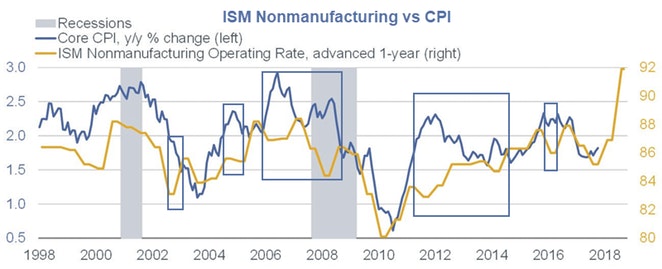ISM A Leading Indicator? Of What?
Mike (Mish) Shedlock | Mar 04, 2018 06:17AM ET

Here's an interesting chart from a tweet today. I cannot make heads or tails out of the proposed idea.
The Claim
The claim is the ISM's nonmanufacturing rate leads changes in core CPI by one year.
The results looks random to me. Correlation and inverse correlation are roughly equal.
The basic problem with these kind of charts is they presume something that happened a year ago has that much influence over events today.
It almost never works out because there are too many other variables. Thus, the boxes that I drew showing inverse correlation happen about 50% of the time.
This ISM variable predicts nothing, at least related to the CPI.
I am not doing this post to knock Sonders. She posts some great charts and lots of interesting ideas. Rather, I wanted to write about ISM anyway.
Survivor Basis
I had lunch yesterday with Jim Bianco, at Bianco Research . We had a great discussion about the ISM.
Since 2007, ISM membership has declined by about 33%. The companies that remain display a survivor bias. They made it through the great recession intact. And they tend to be more bullish.
Jim mentioned a Fed study that came to the same conclusion. The regional manufacturing surveys all have the same flaw.
Jim also mentioned that his firm gets polled in the ISM Nonmanufacturing survey. He has a handful of employees.
His firm has the same weight in the survey as Walmart (NYSE:WMT) which may be hiring or firing thousands of employees. I have mentioned this idea before, but now I have a concrete example to provide.
Questions Start in 2013

On December 2, 2013 MarketWatch commented ISM doubters waiting for hard data to confirm uptrend .
We have no real answer as to why, but given the underlying momentum in the ISM data we can only conclude that at some point the government reports fully reflect private-sector data such as ISM and railroad traffic,” says Steve Blitz, chief economist at ITG.
Get The News You Want
Read market moving news with a personalized feed of stocks you care about.Get The AppStephen Stanley of Pierpont Securities says the nonfarm payrolls data for November — to be released on Friday — will be key. “It was easier to argue that the ISM looked fluky a few months ago. Now, either the ISM figures are giving us leading insight into an imminent boom, or they are just downright wrong. Given the long and storied track record of this indicator, it is difficult to imagine that the ISM figures could be totally off base for so long. And yet, I remain skeptical. I won’t fully believe in the robustness signaled by the ISM figures until I see it in the actual data on production, orders, and employment.”
Response Bias
Historical highs are all distorted not only by the survivor bias but by answering bias. Bianco stopped responding years ago.
How many others stopped responding? At what impact?
Here's a hint: None of the manufacturing reports match actual factory production and they haven't for years.
Think about the Dallas Fed region for a moment. When oil crashed, numerous businesses went under. There's a huge, recent survivor bias in the Dallas Fed region.
Bias Three Ways
We have survivor bias, answering bias, and some unknown ISM bias that started in 2013.
All of these diffusion index reports are so skewed they are historically useless if not entirely useless.
Trading in financial instruments and/or cryptocurrencies involves high risks including the risk of losing some, or all, of your investment amount, and may not be suitable for all investors. Prices of cryptocurrencies are extremely volatile and may be affected by external factors such as financial, regulatory or political events. Trading on margin increases the financial risks.
Before deciding to trade in financial instrument or cryptocurrencies you should be fully informed of the risks and costs associated with trading the financial markets, carefully consider your investment objectives, level of experience, and risk appetite, and seek professional advice where needed.
Fusion Media would like to remind you that the data contained in this website is not necessarily real-time nor accurate. The data and prices on the website are not necessarily provided by any market or exchange, but may be provided by market makers, and so prices may not be accurate and may differ from the actual price at any given market, meaning prices are indicative and not appropriate for trading purposes. Fusion Media and any provider of the data contained in this website will not accept liability for any loss or damage as a result of your trading, or your reliance on the information contained within this website.
It is prohibited to use, store, reproduce, display, modify, transmit or distribute the data contained in this website without the explicit prior written permission of Fusion Media and/or the data provider. All intellectual property rights are reserved by the providers and/or the exchange providing the data contained in this website.
Fusion Media may be compensated by the advertisers that appear on the website, based on your interaction with the advertisements or advertisers.